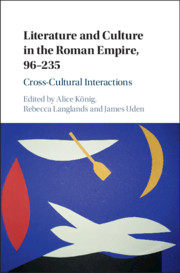Book contents
- Literature and Culture in the Roman Empire, 96–235
- Literature and Culture in the Roman Empire, 96–235
- Copyright page
- Contents
- Figures
- Contributors
- Preface
- Timeline
- Abbreviations
- Map
- Introduction
- Part I Refiguring Roman and Greek Interactions
- Part II Imperial Infrastructure: Documents and Monuments
- Chapter 7 Constructing a New Imperial Paradoxography
- Chapter 8 A Formation of a Christian Archive?
- Chapter 9 Keeping/Losing Records, Keeping/Losing Faith
- Chapter 10 Shaping Buildings into Stories
- Chapter 11 Architectural Criticism in the Roman World and the Limits of Literary Interaction
- Chapter 12 Dying for Justice
- Part III Cultural Translation and Transformation
- References
- Index
Chapter 11 - Architectural Criticism in the Roman World and the Limits of Literary Interaction
from Part II - Imperial Infrastructure: Documents and Monuments
Published online by Cambridge University Press: 28 April 2020
- Literature and Culture in the Roman Empire, 96–235
- Literature and Culture in the Roman Empire, 96–235
- Copyright page
- Contents
- Figures
- Contributors
- Preface
- Timeline
- Abbreviations
- Map
- Introduction
- Part I Refiguring Roman and Greek Interactions
- Part II Imperial Infrastructure: Documents and Monuments
- Chapter 7 Constructing a New Imperial Paradoxography
- Chapter 8 A Formation of a Christian Archive?
- Chapter 9 Keeping/Losing Records, Keeping/Losing Faith
- Chapter 10 Shaping Buildings into Stories
- Chapter 11 Architectural Criticism in the Roman World and the Limits of Literary Interaction
- Chapter 12 Dying for Justice
- Part III Cultural Translation and Transformation
- References
- Index
Summary
The reigns of Nerva, Trajan, and Hadrian are notable both for the technical and aesthetic developments in architecture, as well as the significant amount of building work undertaken in Rome and across the empire. However, as far as can be determined, this activity was not accompanied by a surge of interest in architectural writing among Latin authors of the second century CE, who give little attention to such matters. This chapter aims to demonstrate that while there were shared frameworks for how Roman writers received and commented on buildings, the most important connection between them is what they do not say. This argument is developed through considering the apparent difference with Greek literature of the period, which includes conspicuously more complex discussions of buildings and attention to architectural detail. The case is made that this contrast is not due to a lack of interaction, but is rather a deliberate opposition between how Latin and Greek authors handle the subject. Arguably, this disconnection that is observable in literature also reflects the differing perceptions of architecture in the respective societies more widely.
Keywords
- Type
- Chapter
- Information
- Literature and Culture in the Roman Empire, 96–235Cross-Cultural Interactions, pp. 247 - 268Publisher: Cambridge University PressPrint publication year: 2020

